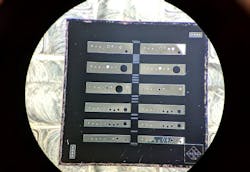CMS crystalline resonators enable interferometer that improves gravitational wave detection
Quantum mechanics places a fundamental limit on the precision of measurements. This effect is directly related to Heisenberg's uncertainty principle, which states that specific pairs of observables cannot be known simultaneously with arbitrary precision. Consequently, many practical measurement schemes create noisy back action on the object that they measure, noise that increases when one tries to measure a given conjugate variable more precisely. Soon, this fundamental noise process will become a limiting factor in the operation of interferometric gravitational-wave detectors such as Advanced LIGO, VIRGO, and KAGRA.
Higher laser powers will be employed in these systems to reduce the position uncertainty created by detector shot noise (here, increases in the photon number arriving on the detectors reduces their limiting measurement noise). However, this enhanced detection sensitivity will come at the expense of back action on the suspended mirrors arising from quantum radiation pressure noise or QRPN. QRPN arises from the random "kicking" of the suspended mirrors via radiation pressure. In this process, momentum transfer from the reflection of randomly arriving photons induces unwanted motion of the mirrors, limiting the precision to which their position can be determined. Once they reach their design sensitivity, detectors such as Advanced LIGO will be limited by QRPN at frequencies between 10 Hz and 100 Hz. In anticipation of this limitation, there exist several proposals to mitigate QRPN, but, until now, no platform has existed to allow for experimental tests of these concepts.
Reporting on progress in this direction, low-loss single-crystal microresonators pioneered by Crystalline Mirror Solutions (CMS; Vienna, Austrai) have now enabled the realization of an optical interferometer in which the ultimate sensitivity of the system is limited by QRPN. Published online on March 25, 2019 in Nature, this work was carried out in collaboration with researchers from Louisiana State University (LSU, Baton Rouge, LA), the Massachusetts Institute of Technology (MIT, Cambridge, MA), and the University of Vienna (Vienna, Austria).
The micromirrors manufactured by CMS were used to develop a testbed optical cavity that will be key for realizing improvements in the performance and reach of future gravitational wave observatories. This testbed can now be employed to study techniques to mitigate fundamental noise processes such as QRPN, with the aim of overcoming the limitations imposed by the Heisenberg uncertainty principle.
Researchers from Thomas Corbitt's group at LSU constructed a centimeter-scale optical cavity consisting of a macroscopic (0.5 inch diameter) back mirror and a micrometer-scale crystalline input mirror based on a GaAs/AlGaAs Bragg mirror suspended by a 220 nm thick x 8 micron wide x 55 micron long GaAs cantilever. Here, the low optical and mechanical losses of the monocrystalline material structure enabled the Brownian noise, or unavoidable thermomechanical fluctuations, of the mirror and cantilever to be minimized. Typically, this noise source masks the subtle effects of quantum optical noise, particularly at room temperature. With careful minimization of extrinsic noise sources, including laser intensity noise among others, the team from LSU and MIT were able to realize an optical cavity that was limited over a broad frequency band in the audio range by QRPN.
This latest achievement once again shows the capability of "semiconductor supermirrors" to redefine the performance metrics of precision optical interferometry, advancing the field of optical metrology and paving the way for improved experimental systems capable of exploring the ultimate limits of measurement sensitivity for fundamental scientific studies. The CMS mirrors are already leading to the development of improved optical clocks, frequency references, and narrow-linewidth laser systems. Future efforts with this quantum-limited cavity will involve further reductions in the limiting noise through the implementation of quantum-enhanced states of light (such as squeezed light injection), back-action evading measurement schemes such as variational readout, and, conversely, the generation of light with reduced fluctuations from the cavity itself via pondermotive squeezing.
CMS was co-founded in 2013 as a spin-off of fundamental physics research from the University of Vienna and the Vienna Center for Quantum Science and Technology by Garrett Cole and Markus Aspelmeyer. CMS was originally established in Vienna, Austria and has since expanded to include sites in Santa Barbara, CA and Klosterneuburg, Austria. Semiconductor supermirrors are a proprietary technology pioneered by CMS and protected by international patents. The application space of this novel mirror technology spans optical components for ultraprecise optical clocks, precision interferometry, spectroscopy, as well as solutions for thermal management in high-power lasers and laser machining systems. CMS has received high-profile technology awards such as the Leibinger Innovation Award, the SPIE Prism Award, and the AMA Innovation Award, as well as various national and international start-up prizes.
SOURCE: Crystalline Mirror Solutions; https://www.crystallinemirrors.com/publication-in-nature/
About the Author

Gail Overton
Senior Editor (2004-2020)
Gail has more than 30 years of engineering, marketing, product management, and editorial experience in the photonics and optical communications industry. Before joining the staff at Laser Focus World in 2004, she held many product management and product marketing roles in the fiber-optics industry, most notably at Hughes (El Segundo, CA), GTE Labs (Waltham, MA), Corning (Corning, NY), Photon Kinetics (Beaverton, OR), and Newport Corporation (Irvine, CA). During her marketing career, Gail published articles in WDM Solutions and Sensors magazine and traveled internationally to conduct product and sales training. Gail received her BS degree in physics, with an emphasis in optics, from San Diego State University in San Diego, CA in May 1986.
